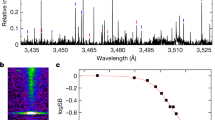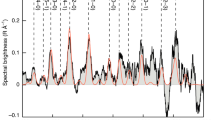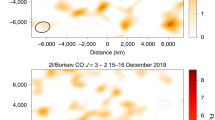Abstract
IN March 1986, the Giotto spacecraft encountered comet Halley, approaching to within ∼600 km of the nucleus. Results from this encounter have shown that the inner coma contains a mixture of cometary neutral gas and dust, thermal ions and electrons, fast cometary pick-up ions, and decelerated solar-wind ions and electrons, as well as fast neutrals1produced by charge exchange between pick-up ions and cold neutrals. Here we report the detection of a new component of the inner coma of comet Halley: negatively charged cometary ions. These ions are observed in three broad mass peaks at 7–19, 22–65 and 85–110 AMU, with densities reaching ≳1, ∼5x10-2 and ∼4x10-2cm-3, respectively, at a distance of ∼ 2,300 km from the nucleus. The ion species thought to be present include O-, OH-, C-, CH-, CN- and heavier complex CHO molecular ions. As negative ions are easily destroyed by solar radiation at ∼1 AU (ref. 2) an efficient production mechanism, so far unidentified, is required to account for the observed densities. The detection of negative ions in the coma near 1 AU implies that in similar neutral gas and dust environments farther away from the Sun (in Jupiter's or Saturn's magnetospheres3, for example), negative ions should also be present. If the negative-ion densities are large enough, they could play an important part in physical processes such as radiative transfer or charge exchange.
This is a preview of subscription content, access via your institution
Access options
Subscribe to this journal
Receive 51 print issues and online access
$199.00 per year
only $3.90 per issue
Buy this article
- Purchase on Springer Link
- Instant access to full article PDF
Prices may be subject to local taxes which are calculated during checkout
Similar content being viewed by others
References
Eviatar, A. & Goldstein, R. Astrophys. J. 339, 545–557 (1989).
Wekhof, A. Moon Planets 24, 157–173 (1981).
Cheng, A. F. Astrophys. J. 242, 812–827 (1980).
Rème, H. et al. J. phys. Engng 20, 721–731 (1987).
Rème, H. et al. Nature 321, 349–352 (1986).
Rème, H. et al. Astr. Astrophys. 187, 33–38 (1987).
Coates, A. J. et al. Nature 327, 489–492 (1987).
Anderson, K. A. et al. Astr. Astrophys. 187, 290–292 (1987).
d'Uston, C. et al. Ann. geophys. 7, 91–96 (1989).
Mazelle, C. et al. Geophys. Res. Lett. 16, 1035–1038 (1989).
Neubauer, F. et al. Nature 321, 352–355 (1986).
Balsiger, H. et al. Nature 321, 330–334 (1986).
Wisemberg, J. & Kockarts, G. J. geophys. Res. 85, 4642–4652 (1980).
Kettmann, G. et al. Ann. Geophys. 8, 229–238 (1990).
Mitchell, D. et al. Adv. space Res. 9, 35 (1989).
Neubauer, F. et al. J. Phys. E20, 714–720 (1987).
Smith, G. P., Lee, L. C., Cosby, P. C., Peterson, J. R. & Moseley, J. T. J. chem. Phys. 68, 3818–3822 (1978).
Lee, L. C. & Smith, G. P. J. chem. Phys. 70, 1727–1735 (1979).
Krankowsky, D. et al. Nature 321, 326–329 (1986).
Grün, E. & Reinhard, R. Spec. Publs Eur. Space Ag. 155, 7–21 (1981).
Arnaudeau, F. et al. Spec. Publs Eur. Space Ag. 224, 21–37 (1984).
Mendis, D. A. et al. Ann. geophys. 7, 99 (1989).
Mitchell, D. et al. Science 237, 626–628 (1987).
Ip, W-H., Astrophys. J. 353, 290–296 (1990).
Tawara, H. Atomic Data and Nuclear Data Tables 22, 491–525 (1978).
Carlson, C. W., Curtis, D. W., Paschmann, G. & Michael, W. Adv. Space Res. 2, 67–70 (1982).
Author information
Authors and Affiliations
Rights and permissions
About this article
Cite this article
Chaizy, P., Rème, H., Sauvaud, J. et al. Negative ions in the coma of comet Halley. Nature 349, 393–396 (1991). https://doi.org/10.1038/349393a0
Received:
Accepted:
Issue Date:
DOI: https://doi.org/10.1038/349393a0
This article is cited by
-
Modulational instability of ion-acoustic waves in multicomponent plasma using \(\kappa \)-deformed Kaniadakis distribution
Pramana (2024)
-
Interaction of Schamel type solitary waves in an electronegative plasma with trapped non-extensive electrons
Indian Journal of Physics (2022)
-
Electrostatic wave breaking limit in a cold electronegative plasma with non-Maxwellian electrons
Scientific Reports (2021)
-
Direct observation of long-lived cyanide anions in superexcited states
Communications Chemistry (2021)
-
Head-on Collision of Ion-Acoustic Shock and Solitary Waves in Collisionless Plasma with Pair Ions and Electrons
Brazilian Journal of Physics (2019)
Comments
By submitting a comment you agree to abide by our Terms and Community Guidelines. If you find something abusive or that does not comply with our terms or guidelines please flag it as inappropriate.



